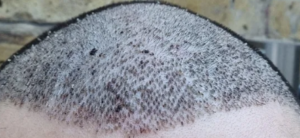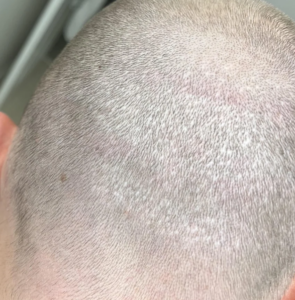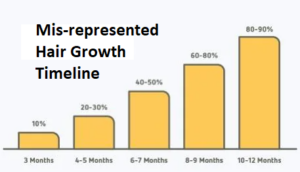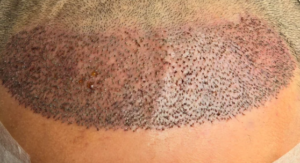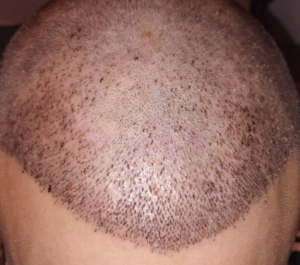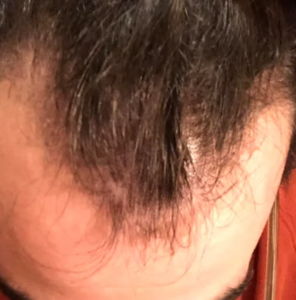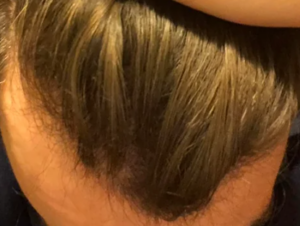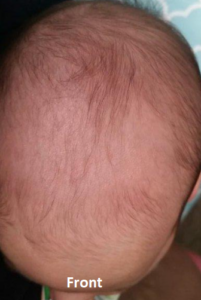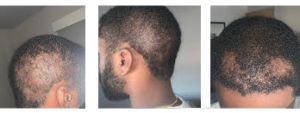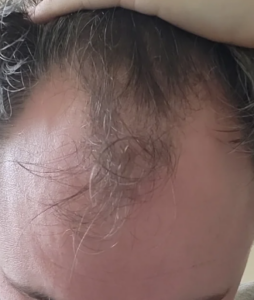The scabbing is a reflection of poor washing techniques. Good washing should take off all scabs by day one. Now, you will have to wait 12 days before removing them gently by leaving a shampoo on your head for 10 minutes, and then gently rub them off with your fingertips. Repeat with multiple washings until it is clean.
This graph was posted online. It suggests a long start-up of the graft growth, which is not the case. This graph is misrepresenting what is happening. The start of growth usually occurs between 2-5 months. When it does, the hair grows at a rate of 1/2 inch per month. I always tell my patients that they can expect styling length hair (at least 1 1/2 inches) by 8 months, if not sooner. The grafts should grow by the 5th month (90%+), maybe not so long, but certainly a beard length initially. The grafts don’t always start at the same time, some might appear at 2 months, more at 3 months, then some a 4 months but by the 5th month, 90% of the grafts will have usually emerged.
How is this looking so far ? You guys think this was a good transplant? It was done yesterday at QHT clinic in India. Does it looking like 2200 grafts? From my experience i was so nervous but it was totally painless now i am just hoping for good result. Please share your views and help anyhow you can . Any tips you have to get better results are welcome.
It looks good. The spacing and the placement seemed first-class. Unfortunately, you never know what happens behind the scenes until you reach 6 months. I particularly like that the recipient site is free of crusting, which reflects well on the people who did this work and your washing technique. What doctor did you use?
I had my hair transplant on thursday 10 and everything was ok until I show a photo to a friend and told me my hair transplant was bad and I won’t get any density on my hair. I saw the doctor and he told me that all was good, but I cant stop overthinking and worrying about what my friend said.
How to deal with that anxiety and thoughts?
With your preoperative photos, I can tell the appropriateness of your hair transplant. What I see looks good as long as the surgeon created a frontal hairline with a good transition zone at the leading edge to ensure that the gradient from your forehead to a full hairline is gradual. I can’t tell by looking at these photos. You can mail me your complete photos if you want a second opinion (pre and post-op photos), and then I could give you a second opinion to calm your anxiety. Write to me at williamrassman33@gmail.com
1
I’m a 31 year old male here. I have been obsessing with getting a transplant for the last 6 months and have read just about everything here on Reddit about it, from the pre/post care, no. of grafts, what to look for in a surgeon, the ugly duckling phase, etc. From my consultation with a few clinics, I am a NW4/5 with a healthy donor area, and approx 4000 grafts will be required for the transplant.
Here is a typical patient’s photo from one day after a hair transplanted by me: https://baldingblog.com/one-day-post-op-2150-grafts-photos/ The pink color was gone in 2 days, and the FUE sites in most of my patients are healed in 3 days. There should be no pain (98% of my patients say that). You say that you need over 4000 grafts, who told you that? Were there any metrics presented to you, like your lifetime donor supply or the value of your hair mass? If your doctor did not supply you with that information, then the doctor didn’t respect you as it was more about your money than educating you about your future donor supplies.
I recently performed a hair transplant on a well-known litigator He went to a trial hearing just 3 days after his FUE hair transplant. We shaved the back of his head and trimmed it to look stylish. The donor site had healed entirely. He called me immediately after the hearing because he knew that he had worried about going to court. He told me the judge commented: “Nice HAIR-DO you got there!” He was relieved and then continued on with the hearing. Many people were in that court hearing, and he managed his appearance well.
There is no difference between FUE and DHI other than marketing hype. The DHI folks have standardized the use of Choi-type implanters. Many other doctors do the same but are not entitled to join the DHI marketing organization.
If one opts for a transplant, is it still necessary to take Finasteride or any other medication?
Since hair loss is progressive, I generally recommend that a person having a hair transplant stay on this drug for life, provided that they don’t have negative side effects. In addition, the drug has value in reducing the risk of prostate cancer (the # one cancer in men) and also reduces the risk of heart disease by lowering cholesterol and possibly directly impacting atherosclerosis. To get the benefits of finasteride to avoid the shock loss, you should be on it at least 2 weeks prior to the transplant.
One month? You are unrealistic if you were expecting significant benefits from finasteride in a month. Give it 9-12 months and then you should see either slowing, stopping or some or all reversal of the hair loss.
If I apply 0.1% 1 ml solution of topical liposomal finasteride daily. That would mean a dose of about 1mg.
If I apply 0.1% of 2ml solution daily. That would mean a dose of about 2mg. Is this what you mean or would I have to change it to 0.05% to keep with the 1mg dose? I believe you have mentioned that about 5% or 18% of the medicine goes systemic. Which one of these would be the better estimate?If you have the time I do have a few more questions:
If my hair loss still regresses, is there a point in increasing the dose? If so, by how much and what would be the limit? Also in your experience how effective is 0.1% for people around my age and does it actually reduce the chances of side effects?
Finally, although I know they are rare, I wanted to get some clarification on the side effects:
I have mild gynecomastia left over from puberty. Does that make me more likely to get finasteride-induced gynecomastia?
Can long-term use of finasteride cause side effects like infertility? If so, in your experience do these always go away once the mediation is stopped?
- I only prescribe the Liposomal form of topical liposomal finasteride, not regular topical finasteride, and step-wise, increasing the dose from 0.01% over a year to the 0.1% ideal dose. I don’t know if I agree with your math. From a practical point of view, what I do works.
- The ideal dose, in my experience, is 0.1%
- I have seen rare reports of side effects that can be offset by lowering the dose to 0.01%
- Juvenile gynecomastia usually doesn’t increase the risk when taking finasteride as an adult or late teen.
- Finasteride is not known to cause infertility, but there are reorts of reduced sperm count for men on finasteride.
- Fertility side effects usually go away in a couple of months after stopping the oral finasteride.
Ive had pretty lame results with minox only the past 8 months so I decided to add microneedling a month ago (.75m once a week with .3mm for topicals 2x a week). Ive been having a pretty big shed as a result and dont know if this is a sign to stay on. I did have an initial minox shed when i first got on min but there wasnt much regrowth after, so Im hoping this would be different.Thoughts?
You should understand that the scalp epidermis is 0.5mm thick, so if you go less than 0.5mm with microneedling, you are not reaching any hair stem cells; in fact, you are not reaching anything. With your 0.75mm length, you are barely going through the scalp’s epidermis. The stem cells that need to be reached are about 1.0- 1.7 mm below the surface of the scalp, so that is why I recommend a depth of 1.25mm to reach those stem cells that control hair growth cycling. The shed may have nothing to do with your microneedling.
They gave me a little certificate upon completion of the transplant with a redo guarantee of the results are poor, I still have it. But I cannot just go back to turkey, the plane ticket there was more expensive than the procedure. I told them I wanted a refund but they gave me the run around for legit 2 months, I got tired of it and ripped into them real bad. After that, they declined to give me a refund and they keep telling me no
The value of seeing a doctor in your country is that you always have recourse, either to get your money back or take action against the clinic that did this to you. A solution, if this is older than 6 months, which in your situation is so, then SMP is part of your solution, but don’t get ripped off doing this again, get a reputable group to do this for you, one that does both transplants and SMP.
The donor hair thickness’s value will dictate the graft quality and quantity you need. Men with coarser hair require fewer grafts and get better results than men with fine hair who require more grafts; even with more grafts, the difference between the results is significantly different. In Turkey, most of the clinics (not physician-run nor driven by such factors that I mentioned above) do not do this analysis but deplete your donor area regardless of your needs.
Page 25 of 1247

